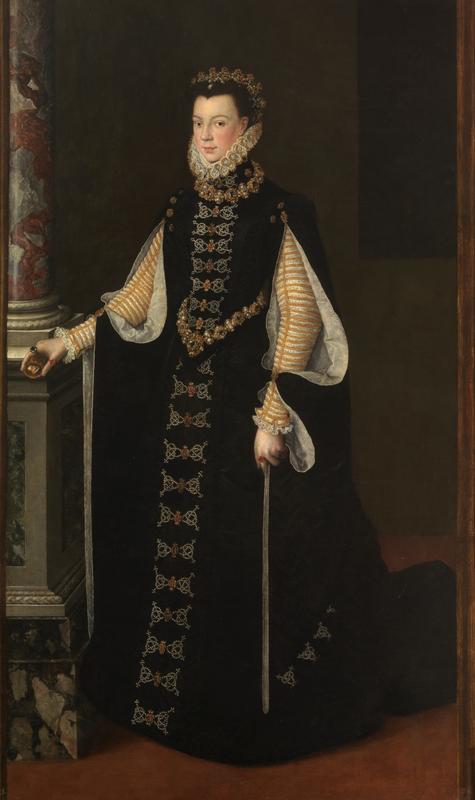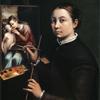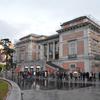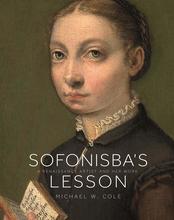More about Isabel de Valois holding a Portrait of Philip II
- All
- Info
- Shop

Contributor
Anguissola's Elisabeth of Valois holding a portrait of Philip II is great not only because of the obstacles overcome by the artist, but also her unmatched technical command of oil paint.
Like Diego Velázquez and Giuseppe Arcimboldo, Anguissola was a court painter. She was also the daughter of a painter. Her material and social privilege, however, did not prevent her from dedicating herself to her work with all the spirit and gusto of an everyday person. A "high-born" woman, but a woman nonetheless, Anguissola had to prove her character, not just her art skills, at every turn.
Many accounts of Anguissola's life between 1559 and 1568 tell us that the great artist was lady-in-waiting, and then painting teacher, to the third wife of King Philip II, Elizabeth of Valois, Queen of Spain. There are two types of queens: 'regnant', a queen who is a reigning monarch in her own right, and consort, which means she is simply the wife of a monarch and has no power of her own. In European nobility, you have to provide your exact genealogical links in order to wield political power as a monarch, a bit like a dog or horse breeder would show the pedigree of the animal. Of course, it's not polite to compare the royals to animals. Elizabeth of Valois did not have royal pedigree, so she was a queen consort, because she married a guy with the holy bloodline, and since she was French, she became the French Queen consort of Spain.
Being Queen consort and foreign, she chose Anguissola, who came with a glowing recommendation from Vasari, the painter and art historian. There's no equivalent of Vasari today, because he taught people how to think about art before anyone was skeptical of a critic telling them what to think. Before rhapsodizing about the brilliance of Anguissola's work, Vasari has to show his "FBI Warning" Disclaimer: before he exposes you to her artwork, he testifies as to the extreme extent of her virginal chastity, so pure and white that he quotes the Pope praising her image of Mary. Her exact pedigree and lineage are the foundation of Vasari's evaluation of her artwork, as well as his evaluation of the virtuous character of Mama and Papa "Anguissola."
Given that art historians have, for centuries, kissed Vasari's high-born tucchus for being the "first art historian ever," it is worth noting that he refers to the artist, one of the greatest in the history of Europe, as the "virgin daughter of...Angusciola," to remind us that the condition of her genitalia is the essential condition for his reading of her artwork. If she were not a virgin, she would either be another man's wife, and his property, and that would make a man's enjoying her artwork some form of adultery-lite, or she would be a cousin of Lillith or Tituba, seducing us with her herbalism and headed for the pyre of a decisive king. Thankfully, because Vasari knows he can't have a doctor go on a hymen inspection, he quotes the Pope. A show of restraint.
Sources
- Avodah Zarah 27a, Babylonian Talmud. Sefaria, https://www.sefaria.org/Avodah_Zarah.27a?lang=bi.
- Diawara, Manthia. "On David Hammons." Mar. 3, 2017, YouTube Video, https://youtu.be/WhwMYkSW564.
- Freer, Martha Walker. Elizabeth de Valois, Queen of Spain and the court of Philip II.: From numerous unpublished sources, in the archives of France, Italy, and Spain. In two volumes. London: Hurst & Blackett, 1857.
- James, Susan E. The Feminine Dynamic in English Art: Women as Consumers, Patrons and Painters. London: Routledge, 2017.
- Langdon, Gabrielle. Medici Women: Portraits of Power, Love and Betrayal from the Court of Duke Cosimo I. Toronto: University of Toronto Press, 2006.
- Miller, Naomi J., and Naomi Yavneh. Sibling Relations and Gender in the Early Modern World: Sisters, Brothers and Others. London: Ashgate Publishing, Ltd., 2006.
- Smith, Bonnie G. The Oxford Encyclopedia of Women in World History 1. Oxford: OUP, 2008.
Featured Content
Here is what Wikipedia says about Portrait of Elisabeth of Valois

Portrait of Elisabeth of Valois is an oil-on-canvas painting executed c.1561–1565 by the Italian artist Sofonisba Anguissola, now in the Museo del Prado in Madrid.
It shows Elisabeth of Valois, third wife of Philip II of Spain. Its iconography derives from Titian's Portrait of Elizabeth of Portugal, Philip's mother. Elisabeth is shown holding a miniature of Philip in her right hand, whilst her black clothing testifies to the austerity of the Spanish court at that time.
Check out the full Wikipedia article about Portrait of Elisabeth of Valois













